Developing Interpersonal Relationships
One of the biggest keys to happiness is having strong interpersonal relationships. I believe that relationships are key to leading a fulfilling and contented life. Like anything worth having in life, they take some work to develop and maintain.
In the spirit of clarity, it’s good idea to take a quick look at the definition of interpersonal relationships.
For instance, I’ve had strong short-lived relationships with people I’ve worked with on a project as well as one for 50 years with my brother. My two best friends and I live in different cities but, we get together several times a year and have a great time. I have a mentor I worked with over a decade ago I still stay in touch with because we get along so well.
We will briefly touch on developing interpersonal relationships. Best way to approach it is to be a good partner or friend as the situation desires.
| A.That’s how interpersonal relationship affects you. |
| B.Interpersonal relationships serve to ease people’s anxiety. |
| C.For instance, ensure you are a good person to work with. |
| D.All of these are examples of strong interpersonal relationships. |
| E.Put some effort into it and you’d be amazed at how that pays off |
| F.An interpersonal relationship is a strong association between people. |
| G.If you’re on a team, it should be something you’d like to help out with. |
相似题推荐
【推荐1】Not long ago, a good friend of mine asked me to help him in a halfway house in Nashville. I agreed and made my way there one evening.
When I got there, I sat with my friend and talked about how he ended up there. As we talked, another man came up, lighting up his cigarette as he sat down. He had dark, leather skin, and looked like he had endured the sun, the rain, and the wind for long, long time. I couldn’t tell how old he was, but I was sure that he was younger than he looked.
Through a bit of conversation, I found out that he had been on the streets for many, many years.
Without my asking, he started describing life as a homeless man. How he got food; how he stayed warm; how he got money. And he told me something that caught my attention.
He said, “You want to know how I keep my stuff safe at night?”
“Sure, “ I replied.
“I put it up in the trees.”
“Why is it safe in the trees?” I asked.
“The homeless are always looking for treasure on the ground--- coins, something someone’s dropped, half-smoked cigarettes. I know if I put my stuff in the trees, they’ll never find it because they never look up. Never. “
Profound words from an unexpected place. And his message is for all of us.
We all have our particular search. We’re looking for treasure on this earth. But what we are REALLY looking for is right there above us. There’s really nothing we need on the ground.
In fact, it’s surrounding us.
1. What did the author go to Nashville for?| A.To help his friend. | B.To build a halfway house. |
| C.To visit a stranger. | D.To pick up a homeless man. |
| A.Enjoyed | B.shared |
| C.Suffered | D.expected |
| A.nobody could climb up the trees | B.there was a hole in the tree |
| C.The leaves of the trees were thick | D.the homeless never looked up |
| A.We should look up for treasure in future |
| B.What we’re looking for is just by our side |
| C.There’s really nothing we need on the ground |
| D.It is wrong to look for treasure on the ground |
【推荐2】Jessica Westervelt,a Spanish teacher at Bethlehem High School in New York,created an activity called “House Hunters”,which was inspired by the popular television show “House Hunters International”,for her Spanish class about four years ago.
Similar to the show,students work in groups,pretending to be real house agents,and look for three houses in Spanish-speaking countries.She uses the activity to teach vocabulary related to the home,chores,travel and vacation.She created the exercise because she wanted to incorporate her students’ interests into the curriculum.At the time,a group of her students were big fans of the show.
The students look for a house for Westervelt to buy to live in,or rent for vacation.She tells them what she is looking for in a home and gives them a budget.Students work in groups of three,and each student is responsible for finding one house in a Spanish-speaking country that fits the requirements.
The groups usually make a brochure describing the houses they find.Each group presents their findings to the class,while the other students take notes.The entire activity is done in Spanish,so students get to practice their writing,listening and conversation skills.They also get some cultural education when researching homes in Spanish-speaking countries.Westervelt says that students planning to take the class look forward to her project.
Westervelt says,“I think any time that you can find a way to link into something that they are interested in outside of school,it makes it more realistic for them and it makes that activity much more enjoyable for them.”
1. How did Westervelt come up with the idea of the activity?| A.She got it from a TV program. | B.She was inspired by her students. |
| C.She learned it from a house agent. | D.She was taught that in high school. |
| A.change | B.absorb |
| C.force | D.persuade |
| A.Rent the houses for their vacation. | B.Live in the houses for a while. |
| C.Write an introduction to the houses. | D.Choose and buy one for their teacher. |
| A.Most school activities are not enjoyable. |
| B.Students should be realistic about study. |
| C.Out-of-school activities are very important. |
| D.Learning should be combined with interest. |
【推荐3】Covid-19 vaccines are starting to roll out in several countries, a momentous breakthrough that hopefully signals a light at the end of this dark pandemic. For Katalin Karikó, the moment is particularly special.
Karikó has spent decades of her career researching the therapeutic(治疗的)possibilities of mRNA, a component of DNA that is considered to be one of the main building blocks of life. Through multiple setbacks, job losses, doubt and transatlantic move, Karikó stood by her conviction(信念): That mRNA could be used for something truly groundbreaking. Now, that work is the basis of the Covid-19 vaccine.
From Hungary to the US
Karikó, 65, began her career in her native Hungary in the 1970s, when mRNA research was new and the possibilities seemed endless. But the call of the American dream(and more researching and funding opportunities)took root.
In 1985, she and her husband and young daughter left Hungary for the US after she got an invitation from Temple University in Philadelphia. They sold their car, Karikó told The Guardian, and stuffed the money—an equivalent of about $1, 200—in their daughter’s teddy bear for safekeeping.
“We had just moved into our new apartment, our daughter was 2 years old, everything was so good, we were happy,” Karikó told the Hungarian news site G7 of her family’s departure “But we had to go.”
She continued her research at Temple, and then at the University of Pennsylvania’s School of Medicine. But by then, the bloom was off the rose of mRNA research, and Karikó’s idea that it could be used to fight disease was considered too radical, too financially risky to fund. She applied for grant(拨款)after grant, but kept getting rejections, and in 1995, she was demoted(降级)from her position at UPenn. She also was diagnosed with cancer around the same time.
“Usually, at that point, people just say goodbye and leave because it’s so horrible,” she told Stat, a health news, in November. “I thought of going somewhere else, or doing something else. I also thought maybe I’m not good enough, not smart enough.”
From doubt to breakthrough
But she stuck with it.
Eventually, Karikó and her former colleague at the University of Pennsylvania, Drew Weissman, developed a method of utilizing synthetic mRNA to fight disease that involves changing the way the body produces virus-fighting material, she explained to CNN’s.
That discovery is now the basis of the Covid-19 vaccine, and some have said both Weissman and Karikó, now a senior vice president of the Germany-based BioNTech, deserve a Nobel Prize.
“If anyone asks me whom to vote for some day down the line, I would put them front and center,” Derek Rossi, one of the founders of pharmaceutical giant Moderna, told Stat. “That fundamental discovery is going to go into medicines that help the world.”
While recognition, after all of this time, must be nice, Karikó says scientific glory isn’t what’s on her mind right now.
“Really, we will celebrate when this human suffering is over, when the hardship and all of this terrible time will end, and hopefully in the summer when we will forget about virus and vaccine. And then I will be really celebrating,” she told CNN’s Chris Cuomo.
Karikó said she plans to get the vaccine soon, along with Weissman, and she said she’s “very, very confident” it will work. After all, it was their discoveries that contributed to it.
In the meantime, Karikó said she allowed herself a little treat to celebrate the vaccine news: a bag of Goobers, her favorite candy.
1. Why did Karikó say “But we had to go.”?| A.Because she was happy with her living conditions in the USA. |
| B.Because she wanted to realize her dream to be an American citizen. |
| C.Because she knew that the decision to go would benefit her research. |
| D.Because she got an invitation from Temple University in Philadelphia. |
| A.Her research made a hit the instant she arrived in the USA. |
| B.She gave up her research for while because of ap' the setbacks. |
| C.People doubted her research and she was denied grant again and again. |
| D.Her research won a let of researching and funding opportunities as expected. |
| A.Perseverance and care for mankind. |
| B.Courage and passion for glory. |
| C.Generosity and burning ambition. |
| D.Curiosity and pursuit of perfection |
| A.Her research on mRNA has won her Nobel Prize. |
| B.Her research establishes the basis of the Covid-19 vaccine. |
| C.She spends years researching mRNA in order to discover the Covid-19 vaccine. |
| D.Her research involves changing the way the body produces healing-itself material. |
| A.The promising future lying ahead. |
| B.The support from her family. |
| C.Her stubborn character. |
| D.Her deep-rooted belief in her research. |
【推荐1】Closeness and independence are both important in our life. Though all humans need both of them, women tend to focus on the first and men on the second. It is as if their lifeblood ran in different directions.
These differences can give women and men differing views of the same situation, as they did in the case of couple I will call Tracy and Brian. When Brian’s old high school friend called him at work and announced he’d be in town on business the following month, Brian invited him to stay for the weekend. That evening he informed Tracy that they were going to have a houseguest, and that he and his friend would go out together the first night to chat like old times. Tracy was upset. She was going to be away on business the week before, and the Friday night when Brian would be out with his friend would be her first night home. But what upset her the most was that Brian had made these plans on his own and informed her of them, rather than discussing them with her before extending the invitation.
Tracy would never make plans, for a weekend or an evening, without first checking with Brian. She can’t understand why he doesn’t show her the same courtesy and consideration that she shows him. But when she protests, Brian says, “I can’t say to my friend, ‘I have to ask my wife for permission’!”
To Brian, checking with his wife means seeking permission, which implies that he is not independent, not free to act on his own. To Tracy, checking with her husband makes her feel good to know and show that she is involved with someone, that her life is bound up with someone else’s.
Tracy and Brian both felt upset by this incident because it cut to the core of their primary concerns. Tracy was hurt because she sensed a failure of closeness in their relationship: He didn’t care about her as much as she cared about him. And he was hurt because he felt she was trying to control him and limit his freedom.
1. What is the primary purpose of the author in writing this passage?| A.To educate the reader on how to maintain good family relationships. |
| B.To tell the reader how to make close connections with other people. |
| C.To suggest the best way of coping with family conflicts. |
| D.To explain the difference in communication styles between men and women. |
| A.she didn’t know Brian’s friend |
| B.she was too busy to meet Brian’s friend |
| C.Brian didn’t care about her and hurt her deeply |
| D.Brian didn’t consult her before inviting his friends home |
| A.She would discuss with Brian. |
| B.She would simply decide on her own. |
| C.She would ask her friends for advice. |
| D.She would buy Brian something expensive first. |
| A.be more emotional |
| B.be easier to get hurt |
| C.emphasize more on sharing |
| D.emphasize more on independence |
【推荐2】Have you ever bought a gift for a friend, simply because it’s a gift that you like yourself?
The study, “I Love the Product, but Will You? The Role of Interpersonal Attachment Styles in Social Projection,” is authored by David, an assistant professor of marketing, and published in Psychology & Marketing. Research results are based on the surveys of 1,272 people.
The research reveals that people who are “secure” in interpersonal settings are the ones most likely to engage in social projection. Conversely(相反),those who are “anxious” in such settings are less likely to assume that others share their own preferences.
“You’d think that secure people who tend to be older, in a committed relationship and earn a higher-income with lots of friends and healthy personal relationships would have a better idea of what someone would like as a gift.
Gifts should be thoughtful. Therefore, secure people should be mindful of their choice of gifts. They need to take caution when selecting and buying gifts.
| A.But that’s not the case. |
| B.However, anxious individuals may not always be the best. |
| C.Secure individuals tend to be older and earn a higher income. |
| D.If so, it’s likely that you projected your own attitudes onto your friend. |
| E.Secure individuals make choices on behalf of others based on their own preferences. |
| F.Thus, they are less likely to make choices for a friend based on their personal attitudes. |
| G.Preferably, these individuals should put their own preferences aside when choosing gifts. |
【推荐3】Social Networking Sites: Are They Changing Human Communication?
It is hardly news that people are using the Internet to communicate with others more and more. Some people fear that someday we will no longer feel the need to talk to one another face to face. However, some recent studies suggest that people communicate, or stay in touch, even more than they used to. Whichever side you fall on, what is clear and without a doubt is that human communication has changed in the 21st century. But results of recent scientific studies may have us reconsider just how much our new communication forms have changed our world.
In June 2008, a British psychiatrist, Himanshu Tyagi, warned that communicating on social networking sites could have a negative effect on the generation of people born after 1990. This generation has never known a world without the Internet. Tyagi says that these people use the Internet to communicate with others so much that they may have trouble forming real relationships. Tyagi is concerned that people may start and end relationships over the Internet. Describing the Internet he said, “It’s a world where everything moves fast and changes all the time, where relationships are quickly ended at the click of a mouse.”
Another psychologist, Dr. Aric Sigman, warned of the physical effects that come with using social networking sites. He suggests that the reduction in the amount of time we spend interacting (互动交流) with people face to face could have biological effects on the human body. The results of his study suggest that, without real personal interaction, the body does not react the same way it would if people were meeting face to face. As a result, immune responses, even hormone levels, can be changed. These changes may lead to the development of illnesses, such as cancer.
Despite these warnings, studies can be found that show the positive sides of social networking sites. The results of one study show that using social networking sites has increased the self-esteem (自尊心) of young adults. Another suggests that college students using these sites feel more “connected” with people when they use them. In addition to scientific studies, there are many who feel that the benefits of social networking sites outweigh the possible negative sides. Many people, especially those who spend a lot of time at home, for various reasons, find the Internet a lifeline. They are able to communicate with many people using these sites.
Perhaps the key to this new communication style is self-control and common sense. If someone spends all of his time on the Internet, and never actually sees friends face to face, that seems like an unhealthy way to live. But if someone spends time on the Internet, some of which is spent arranging meetings for “real” time together, then it seems almost complementary (互补的). Balance is the key to keeping communication alive and well in the 21st century.
1. Which of the following ideas may Himanshu Tyagi agree with?| A.Social networking sites harm people of all ages. |
| B.The Internet weakens young people’s relationships. |
| C.The use of the Internet improves people’s immune system. |
| D.The online world pushes people to live a faster and better life. |
| A.It will stop the face-to-face interaction. |
| B.It reduces the self-esteem of young adults. |
| C.It may cause some serious health problems. |
| D.It makes people feel less connected with others. |
| A.Are greater than. | B.Are heavier than. |
| C.Are more effective than. | D.Are more difficult than. |
CP: Central Point P: Point Sp: Sub-point(次要点) C: Conclusion
A.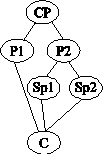 | B.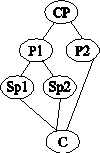 |
C.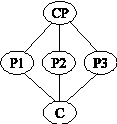 | D.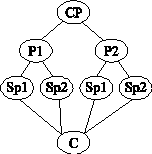 |
【推荐1】It's said that in China millions of legal cases are now being decided by "internet courts" that do not require citizens to appear in court.
The "smart court" includes non-human judges powered by artificial intelligence, or AI. People seeking legal action can register their case on the internet. They can then take part in a digital court hearing. The system gives users the chance to communicate and receive court decisions by text or through major messaging services. Users completed more than 3.1 million legal activities through the court system from March to October in 2019, China's official Xinhua news agency reported.
China's first internet court was established in the eastern city of Hangzhou in 2017. Hangzhou is a center for major Chinese technology companies. Judicial officials recently invited reporters to the Hangzhou Internet Court to see how it operates. In one demonstration, citizens used video messaging to communicate with virtual, Al-powered judges.
"Does the defendant have any objection to the nature of the judicial block-chain (区块链) evidence submitted by the plaintiff 原告)?” a virtual judge asked during a pre-trial meeting. The non-human judge was represented in the system by an image of a man wearing a black robe. "No objection," the human plaintiff answered.
A Hangzhou court official told China's state-run CGTN television that the internet court system operates 24 hours a day, seven days a week. It is designed to ease the workload of humans and improve the speed and effectiveness of the legal process. Court officials say that even though virtual judges are used, human judges observe the process and can make major rulings.
The internet court in Hangzhou only deals with cases involving legal disputes over digital matters. These include internet trade issues, copyright cases and disputes over online product sales. Digital court cases in China have seen a sharp increase in recent years, as the number of mobile payments and internet-based businesses has grown. The growth is tied to China's huge number of internet users --- about 850 million.
After establishing the court in Hangzhou, China launched similar operations in the cities of Beijing and Guangzhou.
1. What can we infer about the internet court?| A.Human judges have played little role in the internet court. |
| B.Citizens can only place their cases on file on weekdays. |
| C.It will become a helper for the court system. |
| D.It has enjoyed great popularity all over China. |
| A.By Al-powered judges. | B.By receiving text messages. |
| C.By attending a court hearing. | D.By registering the cases on the internet. |
| A.Because there is a growing tendency in internet-based businesses. |
| B.Because it is efficient to deal with cases in the internet court. |
| C.Because legal disputes can only be handled in the internet court. |
| D.Because China has the perfect digital court system. |
| A.The Future of the China's Justice. | B.The Future Master of The Internet Court. |
| C.The Growth of Digital Court Cases. | D.The Rise of China's "Internet Courts5. |
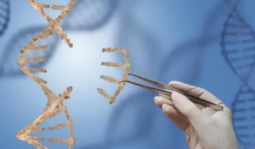
The Royal Swedish Academy of Sciences awarded the Nobel Prize in Chemistry 2020 to two women scientists, Charpentier and Doudna, “for the development of a method for gene editing."
The discovery of these genetic scissors was unexpected.During Charpentier' s studies of Streptococcus pyogenes, one of the bacteria that cause the most harm to humans, she discovered a previously unknown molecule(分子),tracrRNA. Her work showed that tracrRNA is part of bacteria's ancient immune system, CRISPR/Cas. Charpentier published her discovery in Nature in 2011 and described how tracrRNA works with the Cas9 protein(蛋白质)to follow and kill viruses by cutting up their DNA.
Then in that same year,Charpentier began to cooperate with Doudna, an experienced biochemist in RNA.Together, they succeeded in recreating the bacteria's genetic scissors in a test tube and simplifying the scissors' molecular components so they were easier to use.They then reprogrammed the genetic scissors. In their natural form, the scissors recognize DNA from viruses,but Charpentier and Doudna proved that they could be controlled so that they can cut any DNA molecule at a predetermined site. Where the DNA is cut, it is then easy to rewrite the code of life.
Since the CRISPR/Cas9 genetic scissors were discovered in 2012, their use has exploded though there are concerns that the technology could be misused. This tool has contributed to many important discoveries in basic research, and plant researchers have been able to develop crops that withstand mould, pests and drought. In medicine, clinical trials of new cancer therapies are underway,and the dream of being able to cure inherited diseases is about to come true.
1. According to Charpentier's studies of Streptococcus pyogenes, tracrRNA_____| A.can change life's DNA precisely |
| B.causes the most harm to human beings |
| C.is a previously unknown immune system |
| D.works with Cas9 protein to split viruses' DNA |
a. Charpentier began to cooperate with Doudna.
b. Charpentier published her discovery in 2011.
c.Charpentier studied Streptococcus pyogenes.
d. The bacteria's genetic scissors were recreated.
e.The genetic scissors were then reprogrammed
| A.a-b-d-c-e |
| B.c-a-b-e-d |
| C.a-d-e-c-b |
| D.c-b-a-d-e |
| A.Concerns about the misuse of genetic scissors. |
| B.The widely-spread use of the genetic scissors. |
| C.The important discoveries in basic research. |
| D.Contributions to cure for inherited diseases. |
| A.Cooperation:Secret to Success in Scientific Researches |
| B.Genetic Scissors:a Tool for Rewriting the Code of Life |
| C.Charpentier & Doudna:Women Scientists Acknowledged |
| D.The Nobel Prize in Chemistry: a Promoter of Gene Editing |
【推荐3】Can we humans avoid war? Can war be prevented ?
Our task now is not to blame the past,but to plan for the future.
If there is peace in the world, men can use their rockets to explore the mystery of space,their submarines to explore the depth of the sea,their missiles to deliver to mails and their fine equipment to penetrate(穿透)jungles of Africa ,instead of using them military.
Governments can use their money to build more schools,so that more children can be educated to be useful citizens.
We know that neither peace nor such a dream world can come true in a day or month.
| A.How can a peaceful world be achieved? |
| B.The process may even take decades or centuries. |
| C.Peace can be won through the efforts of all human beings. |
| D.Things for military use can be transformed to peaceful use. |
| E.Scientists can use atomic energy to power steamships and planes. |
| F.I am sure that we would not like to experience another world war, |
| G.History tells that there were wars, great or small,in every century, in every decade. |



